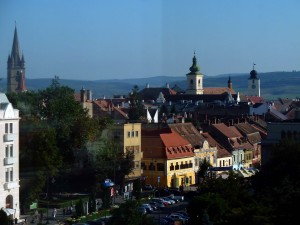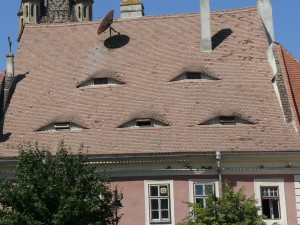Probably one of the most important years in the history of Sibiu, was 2007, when, together with its elder brother Luxembourg, it became the European Capital of Culture. It was a moment in which all of Europe acknowledged the indisputable richness of the cultural and historical heritage of Transylvania in general and Sibiu in particular. Preparing for the great event, the municipality has invested important amounts of money in the rehabilitation of the historical buildings, the main squares and in keeping the city as a clean and friendly setting for all visitors.
Today, a couple of years after this big moment, Sibiu is still one of the top Romanian destinations. We invite you to take a walking tour on the pedestrian area and visit the old Austrian army and administrative houses, to be impressed by the strong fortification walls and defensive towers which once made Sibiu the only Eastern and Central European city, which was never conquered by the Turkish Empire.
Enjoy the unique view, the three main squares have to offer, but also discover the mysteries and legends behind the baroque and renaissance palaces. One of them hosts Transylvania’s first opened museum that is nowadays a splendid arts gallery, called Brukenthal Museum, named after the great Transylvanian governor, owner of the palace and of the collections.
Not far from the Orthodox cathedral, a smaller copy of Holly Sofia basilica of Istanbul, we will find one of the city’s most interesting museums: “the museum of the Lutheran church”. It was opened in 2007 and tells the interesting, but rather sad story of the German inhabitants of Transylvania, also called Saxons. Their whole history, from their arrival in the 12th century, up to the mass emigration of the 20th century, is excellently documented. You have to visit this museum in order to understand more about Transylvania’s history!
At noon, we invite you to just sit back on a terrace on the “little square” and enjoy some of the Romanian traditional dishes, together with a fine glass of wine.
In the afternoon we will drive just outside of the city, in the lovely Dumbrava forest, also called the young forest of Sibiu and visit one of Europe’s biggest open air museums. The first pieces of the exhibition were brought here in the 1960s, when because of the forced communist industrialization, many villages were deserted, leaving century old traditions and buildings behind. A couple of houses, churches, mills and workshops were brought to the museum, to be kept safe and open for visits. Over the next years, hundreds of buildings and objects were brought to an always evolving museum, which nowadays exceeds 100 hectares and is continually growing.
Fortunately, there are still many villages left intact and the local hospitality has remained unaltered by the many social changes. In the small village of Sibiel, we are invited to a local household for a great dinner with homemade local dishes.
In the evening we will return to Sibiu.




